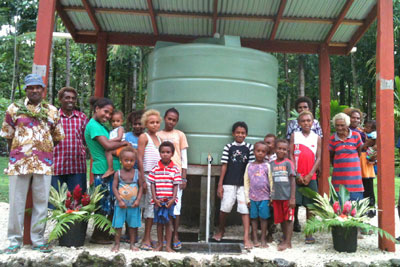Overview
The majority of Solomon Islands’ population of 550,000 live in small rural communities on 90 inhabited islands, dispersed across 1.34 million square kilometers (517,376 square miles) of ocean. Following a period of unrest from 1998–2003, Solomon Islands has moved from post-conflict reconstruction into longer term development. However, the benefits of this growth have been limited to the capital Honiara and its surrounding areas. Improving the living standards of the majority remains a formidable challenge. Agriculture continues to be the backbone of the economy, with most Solomon Islanders relying on subsistence living and smallholder agriculture for income.
Challenge
Service delivery, infrastructure, and the participation of rural communities in the national economy face various constraints in Solomon Islands, including challenging terrain.
There are only five kilometers (3.1 miles) of road per 100 square kilometers (38.6 square miles)–the lowest ratio in the Pacific–and travel in most rural areas is costly by motorboat.
Nationally, less than 20% of people have access to electricity, with rates even lower in the outer islands at less than 5%.
Only 33% have access to piped water, while access to flush toilets stands at 15%.
The effectiveness of government service delivery has been hampered by the fragmentation of rural development financing. This inadequate delivery of services has fueled an increase in individual grant funding, which some suggest is a quicker and more efficient way to channel funds to rural communities. However, accountability systems have to be set in place for this to be an accepted manner of providing basic services to the community.
Solution
Since 2008, the first Rural Development Program (RDP) has progressively scaled up to cover more than 90% of the nation’s rural wards. Living standards in rural areas have improved by empowering communities to design, build and operate small-scale infrastructure and services to meet their highest priority needs. Based on an inclusive, participatory, and community-driven process, small-scale projects have been implemented across the country.
The program has provided grants directly to communities who manage their own funds using stringent financial management, procurement and public reporting practices. The transparency and accountability of this approach helps to minimize potential misuse of funds.
The use of community-managed accounts have helped leverage contributions from the communities themselves, local government and politicians. Support has also been provided to the Ministry of Agriculture and Livestock to provide advice and training to farmers to improve practices and productivity. Supplemental equity grants were also given to rural businesses to allow them to increase their revenue and create jobs in rural areas.
Results
- Over 300 community small scale projects in water, education, electricity, roads and health have been completed – benefitting over 225,000 people, or 50% of the rural population.
- More than 37,000 farmers from all provinces–nearly half of them women– received agricultural advice.
- 58 rural businesses have received equity financing.
To check on its progress since it began operating in 2008, an evaluation was conducted in August 2013 focusing on the first four provinces of the program. It found that:
- Household satisfaction with access to village infrastructure doubled since 2010.
- Villages with satisfactory access to water more than doubled.
- 62.2% of households have access to primary schools – an almost 20% increase.
- 94% of households and 93% of women feel that RDP project investments reflected their needs.
- More than 60% of farmers are satisfied with the agricultural advice they received, and nearly 50% of farmers changed their farming practices accordingly.
- Villages that implemented health projects recorded a 36% increase in satisfaction with access to healthcare – those that didn’t recorded an 18% deterioration in healthcare access satisfaction.
- Women are actively engaged in community groups responsible for managing funds and implementing community projects – the Sub-project Implementation Committee (SIC) – as Chair, Treasurer or Secretary, with women membersin 90% of the committee.
- SIC membership has helped to empower women. Female SIC members are on average 80% more likely to participate in more activities outside their community.




